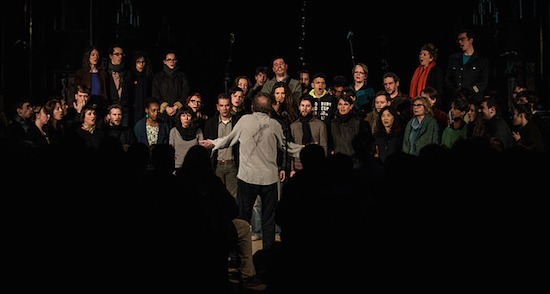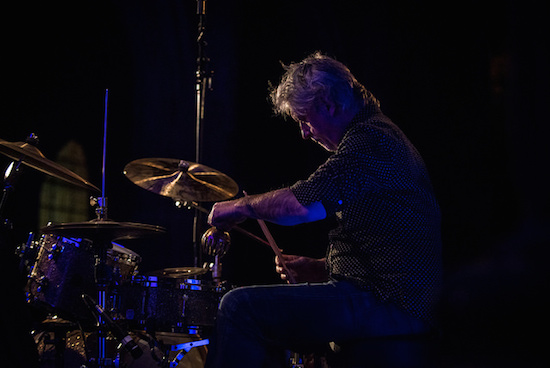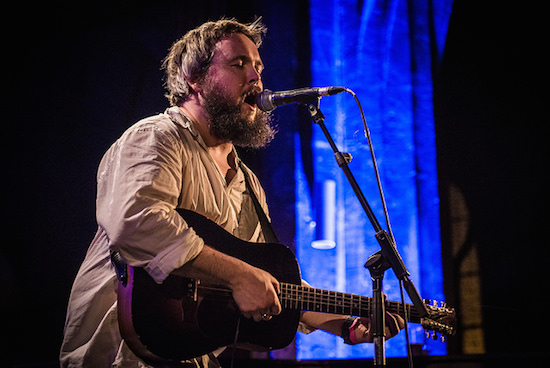All photos by Céline Fernbach
Paris has a complex, even paradoxical relationship with noise and irreverent sounds. The city, given the density of its living spaces, transport routes and businesses within a relatively small space inside the périphérique ring-road is often acutely noisy. Neighbours, bars and juddering métro trains are a frequent source of annoyance for many and the Parisian authorities have, since 2004, established a taskforce to investigate and respond to noise as a significant source of bother. Noise limiting technology is often a bane for live musicians. Drunken late-night pavement chatterers regularly come into conflict with the bleary-eyed locals they’ve just woken up. At the same time, noise in its myriad forms is also valued and celebrated in some parts of the French capital. The Centre Pompidou is home to IRCAM, the noise and acoustics research institute. On a less lofty, theoretical and polar-necked level, the suburb of Montreuil has been home to Les Instants Chavirés since 1991, a famed venue for avant-garde and leftfield sound and oddball music performances. The influential Bimbo Tower record store may be no more, but the <a href="http://www.soufflecontinu.com" target="out>Souffle Continu shop and label continues to sell, promote and issue cutting edge recordings.
Another important emerging institution is Sonic Protest which has organised a yearly festival of esoteric, obscure but intelligently-curated noise and music performance since 2003. Its organisers Franq De Quengo and Arnaud Rivière describe the aim of the festival as foregrounding the human experience of performances and creating something "accessible to all, without baggage or any background knowledge required", and its easy to see how the ethos pervades. In contrast to the rules, regulations and limitations imposed by the Paris town hall and the long-suffering neighbours, Sonic Protest is responsible for creating "daring aesthetic mixtures" and offers an intelligent and sophisticated reconsideration of the City Of Light’s relationship with noise. For De Quengo and Rivière, who proclaim "demanding music for everyone!", noise is a great deal more than just a problem to be regulated.
One of the most interesting aspects of Sonic Protest is its relationship with place. The ten-day festival shuns the traditional city-centre nightclubs and concert halls in favour of unconventional performance spaces both in central Paris and on its more liminal fringes. Events take place at venues like Le Chinois in Montreuil, notorious 1980s home of anti-capitalist squats and violent confrontations between punks and police, Le Générateur in Gentilly, also just beyond the city borders and, most strikingly, at the Saint Merri church right in the middle of Paris, a stone’s throw from both the Pompidou and the Hotel de Ville where, ironically, the anti-noise bureaucrats have their spiritual home.
It’s apt, then, that Sonic Protest 2015 kicks off at Le Centquatre, another interesting space on the fringes of Paris. A former council-run funeral parlour, it is now both an art space and site of community engagement. Bearded middle-class bobos, the Parisian forefathers of the contemporary hipsters, trundle their kids in pushchairs to Keith Haring exhibitions there, but kids from the local tower blocks also use the space to breakdance. For two nights, the centre plays host to We Have An Anchor, an ongoing project which sees musicians including Guy Picciotto from Fugazi, the Dirty Three’s Jim White and Efrim Menuck from Godspeed You! Black Emperor soundtracking filmmaker Jem Cohen’s visual essay, or ‘moving collage’ about the Cap Breton district of Nova Scotia.
There is a pleasing juxtaposition at the heart of this collaboration as the musicians laid down their evocative, part-improvised instrumentals built around traditional folksongs, Fugazian intensity and Godspeed-esque crescendos in the heart of the nineteenth arrondissement, one of Paris’ more impoverished districts. While frequently beautiful, and the resonances between the implicit anti-globalisation message of Cohen’s film and the irreverent spirit of Sonic Protest are clear, the overall event was possibly more sombre, contemplative and low-key that might have been appropriate to launch a festival that prides itself on discordancy. On the other hand, the evening openers, however, Astéreotypique, are completely in the spirit of the festival. Their gleeful post-punk funk was exuberant, overlayed with Mike Skinner-esque spoken word drawls and topped off with both an impromptu Johnny Hallyday cover and some (possibly ill-advised) breakdancing.
Astéreotypique are a collaboration between some Parisian indie musicians and members of a local group for young people with autism, and it is exactly this spirit of inclusion, frequently billing amateur performers alongside established professionals that contributes to the distinctive dynamic of Sonic Protest, reflecting De Quengo and Rivière’s vision. A shared spirit infuses British vocal performer Phil Minton’s Feral Choir project, which sees him appear the following night alongside his singers, featuring members of the Antony day hospital, workshopped and rehearsed in the days immediately preceding the event. The result is an explosive blend of chattering, bird noises, freaky laughter and smiles: great fun for performers and audience alike.

Minton and his choir are appropriately located just in front of the choir stalls at the Saint Merry church, a working place of worship by day. Saint Merry has quickly become synonymous with Sonic Protest, hosting its major performances: 2014 saw Merzbow coming close to blasting the vestry into the Seine with his trademark harsh sounds and festival-goers were given free reign of the church, some watching the dark Pope of noise while perched on the altar. This year, the crowd had less room to roam, but Sonic Protest makes full use of the ecclesiastical space: Thomas Bonvalet and Jean-Luc Guionnet’s brutiste performance took place on the floor between the church transepts.
Legendary minimalist performer/composer Charlemagne Palestine’s collaboration with the acclaimed and industrious French electro-doom performer Mondkopf, recreating their first live project together from 2012, took place on a temporary stage erected under Saint-Merri’s imposing church organ which, alas (particularly considering Palenstine’s previous organ projects) wasn’t used in their performance. Given Mondkopf’s involvement, the night drew a big crowd, but their partnership, tonight at least, proved to be less than the sum of its parts. The pair sat behind desks, looking a little like newsreaders: Mondkopf in perennial black hoodie and Palestine, grand piano to his left decked out in rags and ribbons, looking more perhaps like a lysergically-infused Pearly King in his characteristic psychedelic garb. The fusion of Palestine’s discordant, repetitive chords and Mondkopf’s sinister electronic drones was patchy: it came together wonderfully at points, but the overall impression was of both artists doing their own thing, rather than genuinely collaborating. This possibly isn’t helped by the preparation: Palestine spends the ten minutes prior to stage time very visibly bawling at the Sonic Protest technical team, apparently over a malfunctioning microphone. Given the impeccable credentials of the Sonic Protest sound techs – they make all their artists, unfailingly, sound great and form part of a committed network of talented volunteers – such petulance from a member of avant-garde royalty is a little disappointing.

The following night sees The Necks headline Saint Merry. The Sonic Protest crowd is most regularly ebullient and gently beery; tonight’s ambiance was one of reverence, befitting a place of worship, sure, but also reflecting the awed, hushed tones which their admirers adopt when speaking of the Antipodean improvisers. As the trio take to the stage, mobile phones are extinguished, heads gently bowed and eyes closed. Pianist Chris Andrews opened delicately with some tentative high notes and the drums, percussion and double-bass built little-by-little over the hour-long set. Drummer Tony Buck scares the bejeezus out of everyone with some jarring kick-drum interventions, but The Necks’ performance is one of control and precision, using their instruments to evocatively sketch their own sonic place within the church. This is an impossible place, one that calls to mind those created in HP Lovecraft’s anti-Euclidian palaces. Their precise control of dynamics makes it easy to see why they’ve been cited as Swans’ favourite band: many of Buck’s percussive techniques also seem to have found their way into Michael Gira’s work.
The ascending left field star that is Richard Dawson is visiting Paris for the first time, fresh off the back of a whistle-stop tour of its sights by De Quengo and Rivière and apparently over the moon to be in France. You have to wonder what a French-speaking crowd makes of Dawson as he shuffles on stage, looking bemusedly at his amp, mumbling into his mic and wondering aloud "How to start a gig?". What do they make of his gleefully strange murderous a capella folk songs sung with a no-doubt perplexingly broad Geordie brogue? When he stamps his foot and his rich, powerful voice fills the church acoustics, his performance transcends any problems of cultural translation. Whether or not the crowd understand his lyrics, it is clear that Dawson is claiming his patch of Paris for the North East of England, imposing his own sense of place in the Saint Merry confines.
The closing night of Sonic Protest 2015 takes place in Montreuil, a town on the fringes of the city whose fusion of radical politics and suspicion of Paris suits the festival down to the ground. This is the most conventionally ‘rock’ line-up of this year’s festival. Rising stars of the Paris garage rock scene, T.I.T.S are first up with a raw and unreconstructed set that harked back to both no-wave and early Jon Spencer. Sure, they have swagger and energy, but their performance seems a little too styled, a little too rock & roll within the progressive context of Sonic Protest. Pierre & Bastien, a Paris punk trio, start brightly with joyously geeky oddball melodies that recall the Super Furry Animals and fellow French noise popsters Cheveu but, as the set progresses, they steer towards plodding rock turgidity. It is left, then, to No Balls, comprised of members of The Brainbombs and Noxagt, to provide a fittingly abject, discordant and brutal end to this year’s Sonic Protest. They are less concerned with songs, then with seven-minute slabs of bulldozer intensity, almost the polar opposite of The Necks a few days earlier. The Necks created a space, but No Balls are determined to destroy.
Opening with ‘Come Clean’, the band deliver a set of noise rock that is concurrently both incredibly dumb and acutely clever: the primitive, incessant riffs make you think of the Monks and the Stooges while the complex, controlled bass and drums rhythm section has an almost jazz-esque percussiveness. Trumpeter Dan Råberg, adds to the mix, but is most often standing lost in noise, a lightly bewildered fulcrum for the group. Set closer, the Brainbombs, ‘It’s A Burning Hell’ was an aggressively uncouth and nihilistic bras d’honneur to boring conformity, and an appropriate closer to the festival.
Sitting down write this review, I’d intended to use it as a way of displaying how the Paris avant-garde scene was alive, well and even vibrant in the face of perpetual descriptions of the place as a ‘museum city’. On the whole, that wasn’t actually what Sonic Protest 2015 was all about. Aside from the contributions by Astéreotypique and poet Damien Schultz, my festival hero who peformed his energetic odes every night of the festival (even, wonderfully, from the Saint Merry pulpit), the most vibrant and engaging performances didn’t have their origins inside France. As it get stronger from year to year, Sonic Protest is evolving as potent symbol of typically French revolutionary spirit in terms of how it fosters and encourages its artists to think differently, bringing together performers from around the world to do so. It is a festival that creates and reinforces places of artistic exchange and collaboration in the context of a major European capital city. Paris, of course, has always welcomed artists, radicals and freethinkers from around the world. Sonic Protest is a glorious and important continuation of this lineage – one all the more needed in an age of growing mainstream mediocrity, homogenisation and music festivals sponsored by energy drinks and beer brands.
<div class="fb-comments" data-href="http://thequietus.com/articles/17728-festival-report-sonic-protest-live-review” data-width="550">


